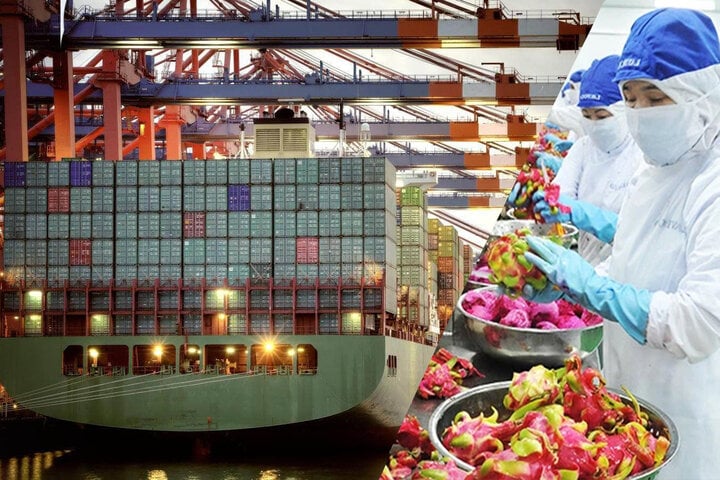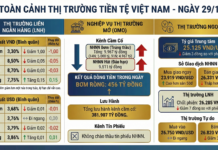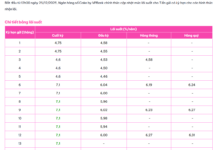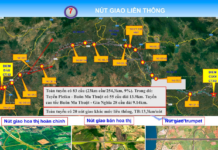Recently, freight rates on key routes have surged. There were times when the price of a container to Europe reached approximately 4,000–5,000 USD, more than double that of last year. Freight rates to the US saw a similar increase, climbing to 6,000–7,000 USD per container. Rates to nearby regions, including China, Japan, South Korea, and Southeast Asia, also rose by 1,000–2,000 USD per container.
This situation has forced domestic exporting businesses to pay extra for each shipment, hurting their profits and making it challenging to compete with rivals.

Soaring ocean freight rates force businesses to spend tens of thousands of dollars extra per shipment. (Illustrative image: Tin nhanh chứng khoán)
Hundreds of thousands of dollars in extra costs each month
A leader of a fruit exporting company in Dong Nai, when interviewed by VTC News, shared that since the beginning of the year, each shipment has brought more worries than joy. The reason is that profits have not increased, but costs have soared by hundreds of thousands of dollars monthly. He added that his company exports nearly 100 shipments monthly. Currently, freight rates to Europe have increased by about 2,500 USD per container, and to the US by 3,500–4,500 USD.
” At the lowest increase of 2,500 USD per container, we still have to spend an additional 250,000 USD per month compared to before. This does not include unexpected costs due to longer sea routes amid the impact of geopolitical conflicts on the maritime industry. Meanwhile, to stay competitive, product prices cannot be raised correspondingly, so businesses have to accept the loss,” he calculated.
Despite facing numerous concerns, Mr. Nguyen Dinh Tung, CEO of Vina T&T Group, expressed relief that freight rates have dropped in the past few days compared to the previous week.
“ Last week, ocean freight rates for a container from Vietnam to the US surged to 8,600–8,700 USD, but this week they have dropped to over 6,000 USD. Although the price is still nearly double that of late 2023, when it was 3,500 USD, it is a bit of a relief for businesses,” he shared.
According to Mr. Tung, his company exports 2–3 containers daily. Thus, each shipment costs tens of thousands of dollars more. If a business cannot negotiate with partners and must sign sales contracts and cover transportation costs, this expense will burden the company significantly.
Mr. Nguyen Van Kich—Chairman of the Board of Directors and General Director of Cafatex JSC (Can Tho), a company specializing in seafood exports to the US and Europe—also informed that Vietnamese enterprises are struggling with soaring ocean freight rates. For a 40-foot container that can hold 15–22 tons of goods, the price surge means an additional cost of nearly 100 million VND. ” Many businesses are scrambling to find ways to survive, such as seeking partner support or entering new markets. However, this is not easy, and some companies have considered limiting exports,” he said.

Businesses spend hundreds of thousands of dollars more each month due to high ocean freight rates. (Illustrative image)
“Burning” containers, paying high prices, and still struggling to find space
Mr. Kich said that most Vietnamese exporting companies are forced to accept high ocean freight rates because they have no other choice, as there is a shortage of containers. ” It’s fortunate to get a spot on a ship at a higher rate. Some shipping lines don’t have any space, meaning that even if you’re willing to pay a higher price, you might not be able to book a container. The reason is that the demand from China is enormous, and they are ready to pay more to secure space,” Mr. Kich explained.
According to Ms. Ngo Tuong Vy, Director of Chanh Thu Company (Ben Tre), in recent years, ocean freight rates have periodically surged, mainly due to a shortage of empty containers amid the impact of COVID-19 or escalating political conflicts.
” Empty containers are concentrated in China due to higher costs, so it is predicted that there will be a shortage of empty containers in Vietnam soon, pushing ocean freight rates even higher,” said Ms. Vy.
Sharing the same view, Mr. Dang Phuc Nguyen, Secretary-General of the Vietnam Vegetables Association, stated that, along with the increase in transportation costs, congestion at transshipment ports has disrupted the entire supply chain, especially for Vietnamese exporters, as their activities heavily rely on foreign shipping lines.
In addition to the conflicts in the Middle East, customers in China are hoarding containers and booking in advance, causing ocean freight rates to skyrocket. The high demand for empty containers in China, a significant exporting country, poses a significant challenge for Vietnamese businesses.
Mr. Truong Quoc Hoe, Secretary-General of the Vietnam Association of Seafood Exporters and Producers, said that since Vietnam’s exports to major markets like the US and the EU depend on foreign shipping lines, it is challenging to avoid some lines taking advantage of the current shortage to raise service rates.
“ When times are tough, they reduce the number of ships, creating a scarcity. This drives up rates. Meanwhile, negotiating and communicating with shipping lines to “share” the difficulties with exporting businesses at this time is entirely impractical,” said Mr. Hoe.
Alternative routes are hard to find
The Ministry of Industry and Trade recently recommended that exporting businesses diversify their goods and routes to reduce costs. For example, they can ship goods by sea to ports in the Middle East and then use air, rail, or road transport to reach Europe.
However, many people believe this is not easy to implement.
Mr. Bach Khanh Nhut, Vice Chairman of the Vietnam Cashew Association, analyzed that traditionally, Vietnamese businesses sign contracts with partners a few months before exporting goods to the European market. Therefore, the Ministry’s recommendation is only suitable when businesses sign back-to-back contracts, spot contracts, or when sea transport is unavailable due to high prices. They will then opt for other means of transport.
For instance, cashew enterprises usually sign contracts at least 3–4 months before the delivery date. During the signing process, foreign partners take responsibility for transportation and hire ships and containers, and they also designate the shipping lines.
Rarely do we have a say in choosing the shipping lines.
Mr. Nhut also stated that when a cashew shipment from Vietnam to the UK arrives at a foreign port for customs clearance, it is guaranteed by enterprises and the local government.
” If we follow the Ministry’s recommendation to transport goods by sea to the Middle East and then use air, rail, or road transport to reach Europe, there will be multiple ports and checkpoints, and who will be responsible for the procedures? Meanwhile, if transported by sea, shipping lines will take responsibility for receiving and delivering goods to partners and ensuring timely delivery,” Mr. Nhut raised the question.
Ms. Ngo Tuong Vy also worried that agricultural products have a limited shelf life, and sea transport takes about 30–40 days, which is acceptable. However, if businesses use sea transport to the Middle East and then switch to air, rail, or road transport to reach Europe, the transit time could increase by about 10–20 days.
” Moreover, transporting from the Middle East to European countries by rail or road involves passing through multiple checkpoints and strict controls, increasing the risk of damage to the goods,” Ms. Vy said.
Mr. Nguyen Van Kich judged: “ If businesses export to China, they can switch from sea to road transport. However, for exports to Europe or the US, there is no alternative to sea transport.”
Foreign shipping company raises fees, import-export businesses “in tears”
In early February 2024, overseas shipping companies announced a 10-20% increase in Terminal Handling Charges (THC) for each type of container service.






































